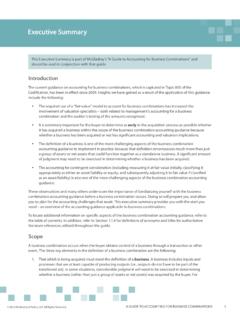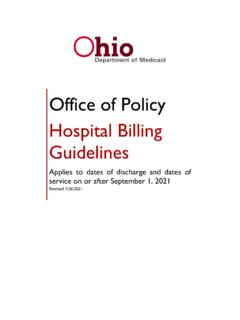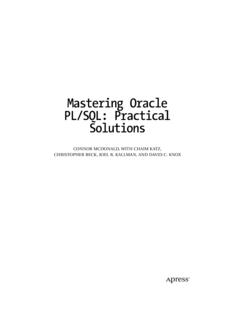Transcription of U.S. GAAP vs. IFRS: Contingencies and provisions
1 gaap vs. IFRS: Contingencies and provisions Prepared by: Richard Stuart, Partner, National Professional Standards Group, RSM US LLP +1 203 905 5027 February 2020 Introduction Currently, more than 120 countries require or permit the use of International Financial Reporting Standards (IFRS), with a significant number of countries requiring IFRS (or some form of IFRS) by public entities (as defined by those specific countries). Of those countries that do not require use of IFRS by public entities, perhaps the most significant is the The Securities and Exchange Commission (SEC) requires domestic registrants to apply generally accepted accounting principles ( gaap ), while foreign private issuers are allowed to use IFRS as issued by the International Accounting Standards Board (which is the IFRS focused on in this comparison).
2 While the SEC continues to discuss the possibility of allowing domestic registrants to provide supplemental financial information based on IFRS (with a reconciliation to gaap ), there does not appear to be a specified timeline for moving forward with that possibility. Although the SEC currently has no plans to permit the use of IFRS by domestic registrants, IFRS remains relevant to these entities, as well as private companies in the , given the continued expansion of IFRS use across the globe. For example, many companies are part of multinational entities for which financial statements are prepared in accordance with IFRS, or may wish to compare themselves to such entities.
3 Alternatively, a company s business goals might include international expansion through organic growth or acquisitions. For these and other reasons, it is critical to gain an understanding of the effects of IFRS on a company s financial statements. To start this process, we have prepared a series of comparisons dedicated to highlighting significant differences between gaap and IFRS. This particular comparison focuses on the significant differences between gaap and IFRS when accounting for Contingencies and provisions . The general guidance on accounting for Contingencies in gaap is included in the Financial Accounting Standards Board s Accounting Standards Codification (ASC) Topic 450, Contingencies , and guidance on accounting for specific types of Contingencies is included in other ASC topics, such as ASC 410, Asset Retirement and Environmental Obligations, and ASC 420, Exit or Disposal Cost Obligations.
4 For gaap purposes, the term general loss contingency is used in this comparison to refer to those Contingencies that fall within the scope of ASC 450. In IFRS, the guidance related to Contingencies and provisions is included in International Accounting Standard (IAS) 37, provisions , Contingent Liabilities and Contingent Assets. 2 AUDIT | FEBRUARY 2020 Comparison The significant differences between gaap and IFRS related to Contingencies and provisions are summarized in the following table. gaap IFRS Relevant guidance ASC 410, 420 and 450 IAS 37 Definitions The Master Glossary of the ASC defines a contingency as follows: An existing condition, situation, or set of circumstances involving uncertainty as to possible gain (gain contingency) or loss (loss contingency) to an entity that will ultimately be resolved when one or more future events occur or fail to occur.
5 Paragraph 10 of IAS 37 defines a provision as a liability of uncertain timing or amount. Paragraph 10 of IAS 37 defines a contingent liability as a possible obligation that arises from past events and whose existence will be confirmed only by the occurrence or non- occurrence of one or more uncertain future events not wholly within the control of the entity. Paragraph 10 of IAS 37 also includes in the definition of a contingent liability a present obligation that arises from past events, but is not recognised because: (i) it is not probable that an outflow of resources embodying economic benefits will be required to settle the obligation; or (ii) the amount of the obligation cannot be measured with sufficient reliability.
6 A contingent asset is defined in paragraph 10 of IAS 37 as a possible asset that arises from past events and whose existence will be confirmed only by the occurrence or non- occurrence of one or more uncertain future events not wholly within the control of the entity. 3 AUDIT | FEBRUARY 2020 gaap IFRS Recognition threshold To recognize a general loss contingency, the loss must be probable. Probable is generally interpreted as likely and is not defined by reference to a single percentage threshold. The intent is that probable be interpreted as a high likelihood. While a numeric standard for probable does not exist, practice generally considers an event that has a 75% or greater likelihood of occurrence to be probable.
7 A provision must be probable to be recognized. Probable is interpreted as more likely than not ( , a probability of greater than 50 percent). Measurement General loss Contingencies are only recognized when they are probable and reasonably estimable. When there is a range of possible outcomes for a general loss contingency, the amount accrued should be the most likely outcome within the range. If no single outcome within the range is more likely than the others, the minimum amount in the range should be accrued. A probable loss contingency is measured at the single most likely outcome even if the other possible outcomes are mostly higher or lower than that amount.
8 provisions must be reliably estimable to be recognized. When there is a range of possible outcomes for a provision, the amount accrued should be the best estimate of the obligation (the amount an entity would rationally pay to settle or transfer to a third party the obligation at the balance-sheet date). If no single outcome within the range represents the best estimate, the midpoint of the range should be accrued. Discounting Typically, a general loss contingency is not discounted unless the aggregate amount of the liability and the timing of cash payments for the liability are fixed or determinable. However, even in such circumstances, discounting is an accounting policy choice, rather than a requirement.
9 The anticipated cash flows to settle an obligation are discounted using a pre-tax discount rate that reflects the current market assessments of the time value of money and the risks specific to the liability , if the effect is material. provisions must be reviewed at the end of each reporting period and adjusted to reflect the current best estimate. The carrying amount of a provision 4 AUDIT | FEBRUARY 2020 gaap IFRS increases in each period to reflect the passage of time with said increase recognized as a borrowing cost. Onerous contracts Unless specifically required by other gaap , obligations arising from onerous contracts generally are not recognized.
10 An onerous contract is a contract in which the unavoidable costs of meeting the obligations under the contract, which is the lower of the net costs of fulfilling the contract or the cost of terminating it, exceed the expected economic benefits. If such a contract exists, the reporting entity should recognize the present obligation as a provision. Asset retirement obligations (ARO) A liability for an ARO is initially recognized when a legal obligation arises in connection with the acquisition, construction or development of a long-lived asset. The liability is measured at its fair value. If the expected cash flow approach is used to estimate the fair value of the ARO, a credit-adjusted, risk-free rate is used for discounting.













